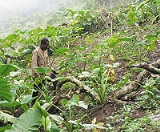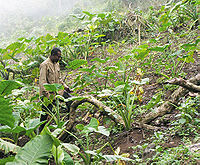
Economy of Cameroon
Encyclopedia
For a quarter-century following independence, Cameroon was one of the most prosperous countries in Africa
. The drop in commodity prices for its principal export
s —petroleum
, cocoa, coffee
, and cotton
— in the mid-1980s, combined with an overvalued currency
and economic mismanagement, led to a decade-long recession
. Real per capita GDP
fell by more than 60% from 1986 to 1994. The current account and fiscal deficits widened, and foreign debt grew. Yet because of its oil reserves
and favorable agricultural conditions, Cameroon still has one of the best-endowed primary commodity economies in sub-Saharan Africa
.
 The government embarked upon a series of economic reform programs supported by the World Bank
The government embarked upon a series of economic reform programs supported by the World Bank
and International Monetary Fund
(IMF) beginning in the late 1980s. Many of these measures have been painful; the government slashed civil service
salaries by 65% in 1993. The CFA franc
— the common currency of Cameroon and 13 other African states — was devalued by 50% in January 1994. The government failed to meet the conditions of the first four IMF programs.
Recent signs, however, are encouraging. As of March 1998, Cameroon's fifth IMF program — a 3-year enhanced structural adjustment program approved in August 1997 — is on track. Cameroon has rescheduled its Paris Club
debt at favorable terms. GDP has grown by about 5% a year beginning in 1995. There is cautious optimism that Cameroon is emerging from its long period of economic hardship.
The Enhanced Structural Adjustment Facility
(ESAF) signed recently by the IMF and Government of Cameroon calls for greater macroeconomic planning and financial accountability; privatization
of most of Cameroon's nearly 100 remaining non-financial parastatal enterprises; elimination of state marketing board monopolies
on the export of cocoa, certain coffees, and cotton; privatization and price competition in the banking sector; implementation of the 1992 labor code; a vastly improved judicial system; and political liberalization to boost investment.
France
is Cameroon's main trading partner and source of private investment and foreign aid. Cameroon has an investment guaranty agreement and a bilateral accord with the United States
. USA investment in Cameroon is about $1 million, most of it in the oil sector. Inflation has been brought back under control.
Less than 5 percent of Cameroonians have access to a bank account. While the microfinance sector is consequently becoming increasingly important, its development is hampered by a loose regulatory and supervisory framework for microfinance institutions (MFIs). The banking sector is highly concentrated and dominated by foreign commercial banks. 6 out of the 11 largest commercial banks are foreign-owned, and the three largest banks hold more than 50 percent of total financial system assets. While foreign banks generally display good solvency ratios, small domestic banks are in a much weaker position. Their capitalization is well below the average of banks in the CEMAC region and their profits are close to 2 percent, compared to 20 percent for foreign banks in the country. This is partially explained by the high levels of non-performing loans, which reached 12 percent in 2007, leading to most banks holding large amounts of excess reserves as a percentage of deposits and large levels of unutilized liquidity.
Africa
Africa is the world's second largest and second most populous continent, after Asia. At about 30.2 million km² including adjacent islands, it covers 6% of the Earth's total surface area and 20.4% of the total land area...
. The drop in commodity prices for its principal export
Export
The term export is derived from the conceptual meaning as to ship the goods and services out of the port of a country. The seller of such goods and services is referred to as an "exporter" who is based in the country of export whereas the overseas based buyer is referred to as an "importer"...
s —petroleum
Petroleum
Petroleum or crude oil is a naturally occurring, flammable liquid consisting of a complex mixture of hydrocarbons of various molecular weights and other liquid organic compounds, that are found in geologic formations beneath the Earth's surface. Petroleum is recovered mostly through oil drilling...
, cocoa, coffee
Coffee
Coffee is a brewed beverage with a dark,init brooo acidic flavor prepared from the roasted seeds of the coffee plant, colloquially called coffee beans. The beans are found in coffee cherries, which grow on trees cultivated in over 70 countries, primarily in equatorial Latin America, Southeast Asia,...
, and cotton
Cotton
Cotton is a soft, fluffy staple fiber that grows in a boll, or protective capsule, around the seeds of cotton plants of the genus Gossypium. The fiber is almost pure cellulose. The botanical purpose of cotton fiber is to aid in seed dispersal....
— in the mid-1980s, combined with an overvalued currency
Currency
In economics, currency refers to a generally accepted medium of exchange. These are usually the coins and banknotes of a particular government, which comprise the physical aspects of a nation's money supply...
and economic mismanagement, led to a decade-long recession
Recession
In economics, a recession is a business cycle contraction, a general slowdown in economic activity. During recessions, many macroeconomic indicators vary in a similar way...
. Real per capita GDP
Gross domestic product
Gross domestic product refers to the market value of all final goods and services produced within a country in a given period. GDP per capita is often considered an indicator of a country's standard of living....
fell by more than 60% from 1986 to 1994. The current account and fiscal deficits widened, and foreign debt grew. Yet because of its oil reserves
Oil reserves
The total estimated amount of oil in an oil reservoir, including both producible and non-producible oil, is called oil in place. However, because of reservoir characteristics and limitations in petroleum extraction technologies, only a fraction of this oil can be brought to the surface, and it is...
and favorable agricultural conditions, Cameroon still has one of the best-endowed primary commodity economies in sub-Saharan Africa
Sub-Saharan Africa
Sub-Saharan Africa as a geographical term refers to the area of the African continent which lies south of the Sahara. A political definition of Sub-Saharan Africa, instead, covers all African countries which are fully or partially located south of the Sahara...
.
Macro-economic trend
This is a chart of trend of gross domestic product of Cameroon at market prices estimated by the International Monetary Fund with figures in millions of Central African CFA Francs.| Year | Gross Domestic Product | US Dollar Exchange |
|---|---|---|
| 1980 | 1,600,186 | 209.20 Francs |
| 1985 | 4,355,977 | 471.12 Francs |
| 1990 | 3,804,428 | 300.65 Francs |
| 1995 | 4,686,286 | 518.62 Francs |
| 2000 | 6,612,385 | 658.21 Francs |
| 2005 | 8,959,279 | 527.29 Francs |

World Bank
The World Bank is an international financial institution that provides loans to developing countries for capital programmes.The World Bank's official goal is the reduction of poverty...
and International Monetary Fund
International Monetary Fund
The International Monetary Fund is an organization of 187 countries, working to foster global monetary cooperation, secure financial stability, facilitate international trade, promote high employment and sustainable economic growth, and reduce poverty around the world...
(IMF) beginning in the late 1980s. Many of these measures have been painful; the government slashed civil service
Civil service
The term civil service has two distinct meanings:* A branch of governmental service in which individuals are employed on the basis of professional merit as proven by competitive examinations....
salaries by 65% in 1993. The CFA franc
CFA franc
The CFA franc is the name of two currencies used in Africa which are guaranteed by the French treasury. The two CFA franc currencies are the West African CFA franc and the Central African CFA franc...
— the common currency of Cameroon and 13 other African states — was devalued by 50% in January 1994. The government failed to meet the conditions of the first four IMF programs.
Recent signs, however, are encouraging. As of March 1998, Cameroon's fifth IMF program — a 3-year enhanced structural adjustment program approved in August 1997 — is on track. Cameroon has rescheduled its Paris Club
Paris Club
The Paris Club is an informal group of financial officials from 19 of some of the world's biggest economies, which provides financial services such as war funding, debt restructuring, debt relief, and debt cancellation to indebted countries and their creditors...
debt at favorable terms. GDP has grown by about 5% a year beginning in 1995. There is cautious optimism that Cameroon is emerging from its long period of economic hardship.
The Enhanced Structural Adjustment Facility
Enhanced structural adjustment facility
The Enhanced Structural Adjustment Facility was a program of financial assistance given to poor countries from December 1987 through 1999 through the International Monetary Fund...
(ESAF) signed recently by the IMF and Government of Cameroon calls for greater macroeconomic planning and financial accountability; privatization
Privatization
Privatization is the incidence or process of transferring ownership of a business, enterprise, agency or public service from the public sector to the private sector or to private non-profit organizations...
of most of Cameroon's nearly 100 remaining non-financial parastatal enterprises; elimination of state marketing board monopolies
Monopoly
A monopoly exists when a specific person or enterprise is the only supplier of a particular commodity...
on the export of cocoa, certain coffees, and cotton; privatization and price competition in the banking sector; implementation of the 1992 labor code; a vastly improved judicial system; and political liberalization to boost investment.
France
France
The French Republic , The French Republic , The French Republic , (commonly known as France , is a unitary semi-presidential republic in Western Europe with several overseas territories and islands located on other continents and in the Indian, Pacific, and Atlantic oceans. Metropolitan France...
is Cameroon's main trading partner and source of private investment and foreign aid. Cameroon has an investment guaranty agreement and a bilateral accord with the United States
United States
The United States of America is a federal constitutional republic comprising fifty states and a federal district...
. USA investment in Cameroon is about $1 million, most of it in the oil sector. Inflation has been brought back under control.
Finance and Banking
Cameroon’s financial system is the largest in the CEMAC region. Access to financial services is limited, particularly for SMEs. Aside from a traditional tendency for banks to prefer dealing with large, established companies, determining factors are also found in interest rates for loans to SMEs being capped at 15 percent and being heavily taxed. As of 2006, bank loans to SMEs hardly reached 15 percent of total outstanding loans.Less than 5 percent of Cameroonians have access to a bank account. While the microfinance sector is consequently becoming increasingly important, its development is hampered by a loose regulatory and supervisory framework for microfinance institutions (MFIs). The banking sector is highly concentrated and dominated by foreign commercial banks. 6 out of the 11 largest commercial banks are foreign-owned, and the three largest banks hold more than 50 percent of total financial system assets. While foreign banks generally display good solvency ratios, small domestic banks are in a much weaker position. Their capitalization is well below the average of banks in the CEMAC region and their profits are close to 2 percent, compared to 20 percent for foreign banks in the country. This is partially explained by the high levels of non-performing loans, which reached 12 percent in 2007, leading to most banks holding large amounts of excess reserves as a percentage of deposits and large levels of unutilized liquidity.

